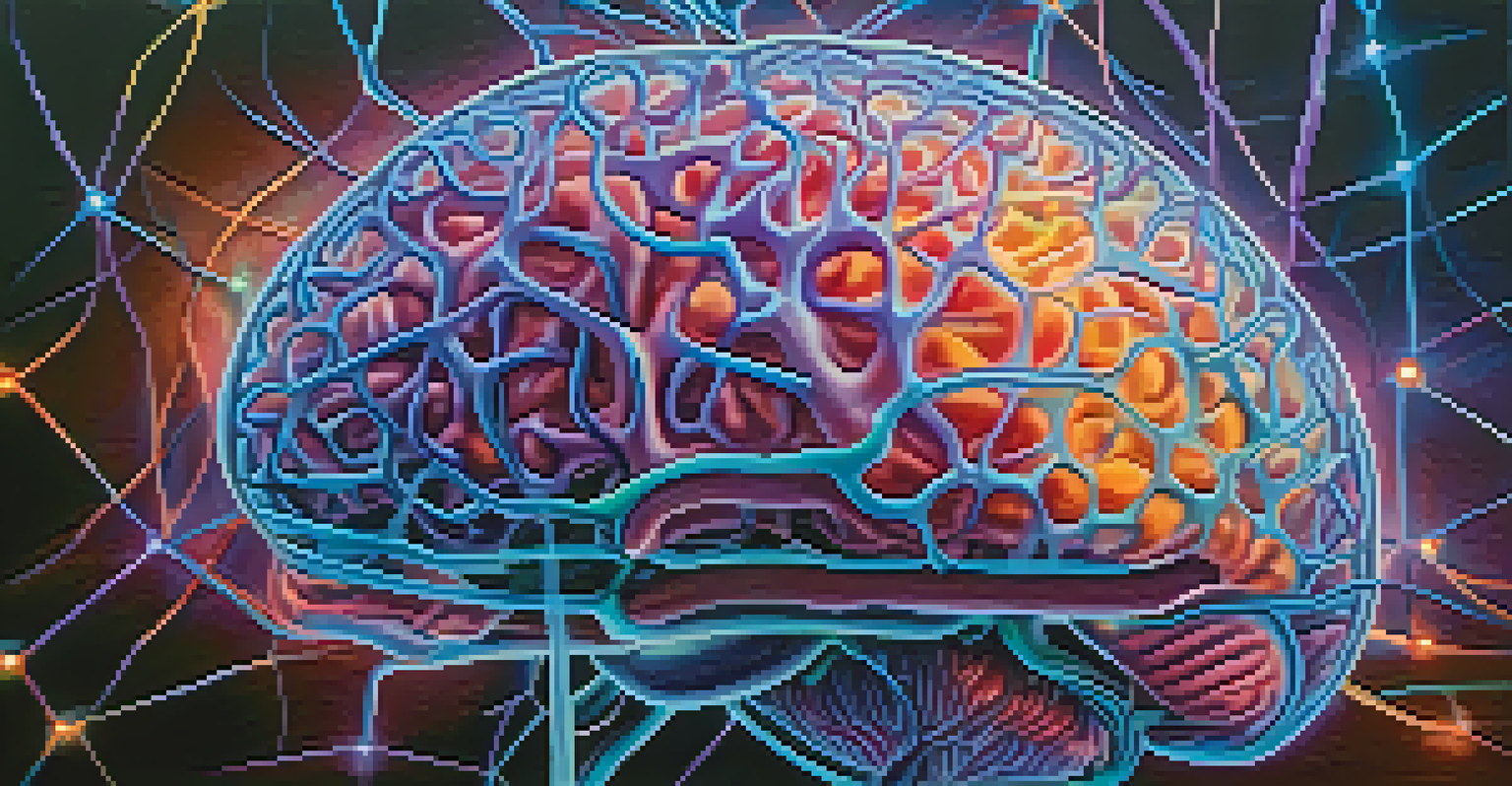Neural Correlates of Consciousness During Hallucinations

Understanding Consciousness and Hallucinations
Consciousness is a complex state of awareness involving perception, thought, and emotion. When we talk about hallucinations, we're referring to experiences that seem real but occur without external stimuli. These can manifest as visual, auditory, or even tactile sensations, leading to a blurred line between reality and imagination.
The greatest discovery of my generation is that a human being can alter his life by altering his attitude.
In essence, hallucinations challenge our understanding of what it means to be conscious. They raise questions about how the brain constructs our experiences and what happens when that construction goes awry. This intersection of consciousness and hallucination is vital for researchers aiming to unravel the mysteries of the mind.
By studying hallucinations, scientists can gain insights into the neural mechanisms that underlie consciousness itself. This exploration not only helps us understand mental health conditions but also sheds light on the fundamental workings of human cognition.
The Role of Neural Correlates in Conscious Experience
Neural correlates of consciousness (NCC) refer to the specific brain processes associated with conscious experience. Identifying these correlates is crucial for understanding how different states of consciousness arise, including those experienced during hallucinations. It's like tracing the electrical wiring that powers a device; without understanding that wiring, we can't fully grasp the device's functionality.

Researchers utilize various imaging techniques, such as fMRI and PET scans, to observe brain activity during hallucinations. These tools help pinpoint areas of the brain that light up in response to these vivid experiences. By mapping these correlates, scientists can begin to piece together how hallucinations alter our perception of reality.
Hallucinations Challenge Consciousness
Hallucinations blur the lines between reality and imagination, prompting researchers to explore how the brain constructs our experiences.
Understanding the neural correlates involved in hallucinations can also inform treatment approaches for conditions like schizophrenia, where such experiences are common. By knowing which brain regions are activated, targeted therapies can be developed to help manage or reduce these episodes.
Hallucinations in Different Mental Health Conditions
Hallucinations are often associated with a variety of mental health conditions, including schizophrenia, bipolar disorder, and severe depression. Each of these conditions offers a unique perspective on how the brain's neural correlates function during altered states of consciousness. For instance, a person with schizophrenia may experience auditory hallucinations, hearing voices that others cannot.
The mind is everything. What you think you become.
The differences in hallucinations across conditions highlight the complexity of the brain's functioning. For example, in bipolar disorder, hallucinations may occur during manic episodes, linking emotional states to conscious experiences. This relationship between emotion and perception further emphasizes the intricate workings of the mind.
By studying these variations, researchers can better understand the underlying neural mechanisms that contribute to hallucinations. This knowledge is crucial for developing effective interventions, as it paves the way for personalized treatment strategies tailored to individual experiences.
Neuroscientific Approaches to Hallucination Research
Neuroscientific research into hallucinations often leverages advanced technologies to explore brain activity. Techniques such as electroencephalography (EEG) and magnetoencephalography (MEG) allow scientists to measure electrical and magnetic fields produced by brain activity in real-time. These methods provide insights into the temporal dynamics of hallucinations, revealing how quickly they arise and dissipate.
Experimental studies often involve inducing hallucinations in a controlled setting, helping researchers observe the brain's response. For example, the use of virtual reality can create immersive environments that trigger hallucinatory experiences. This hands-on approach allows for a deeper understanding of how neural correlates interact with sensory input during these episodes.
Neural Correlates Reveal Insights
Identifying the neural correlates of consciousness helps scientists understand the brain processes involved in hallucinations and informs treatment strategies.
The findings from such studies are essential for creating models of consciousness that include hallucinatory experiences. By integrating these models into broader frameworks of mental health, researchers can foster a more comprehensive understanding of consciousness itself.
The Impact of Neurotransmitters on Hallucinations
Neurotransmitters play a pivotal role in regulating mood, perception, and cognition. Chemicals like dopamine and serotonin are closely linked to the experience of hallucinations, influencing how the brain interprets sensory information. For instance, elevated dopamine levels have been associated with increased hallucinations, often seen in conditions like schizophrenia.
When neurotransmitter systems become dysregulated, the brain's ability to accurately represent reality may falter. This dysregulation can lead to the vivid, often disruptive, experiences characteristic of hallucinations. Understanding the biochemical underpinnings of these experiences is crucial for developing pharmacological interventions.
Researchers are continuously exploring how adjusting neurotransmitter levels can mitigate hallucinations. This line of inquiry not only aids in treating mental health conditions but also enhances our overall understanding of consciousness and perception.
The Influence of Environment and Context on Hallucinations
The context in which hallucinations occur can significantly shape the nature of the experience. Environmental factors, such as stress, trauma, or even sensory deprivation, can influence how and when hallucinations arise. Imagine being in a dark room—your mind might play tricks on you, making you hear sounds or see shadows that aren't there.
Cultural and social contexts also play a role in shaping hallucinations. Different cultures have varying interpretations of these experiences, which can influence how individuals perceive and react to them. For instance, in some cultures, hallucinations may be seen as spiritual experiences, while in others, they may be viewed as symptoms of illness.
Context Shapes Hallucinatory Experiences
Environmental and cultural factors significantly influence the nature of hallucinations, highlighting the importance of a holistic approach to understanding consciousness.
By examining the interplay between environment, culture, and hallucinations, researchers gain a more holistic view of consciousness. This understanding can guide treatment approaches that consider not just the neurological aspect but also the social and psychological dimensions.
Future Directions in Hallucination Research
As research into the neural correlates of consciousness during hallucinations evolves, new methodologies and technologies will emerge. Future studies may incorporate artificial intelligence and machine learning to analyze complex brain data, uncovering patterns that were previously hidden. This could lead to breakthroughs in understanding the intricate relationship between neural activity and conscious experience.
Moreover, interdisciplinary approaches combining neuroscience, psychology, and philosophy will enrich our understanding of consciousness. By integrating insights from various fields, researchers can develop comprehensive models that account for the subjective nature of hallucinations.

Ultimately, ongoing research promises to deepen our understanding of the human mind, paving the way for innovative treatments and a more nuanced grasp of consciousness itself. As we continue to explore the neural correlates of consciousness, the potential for enhancing mental health and well-being becomes increasingly tangible.